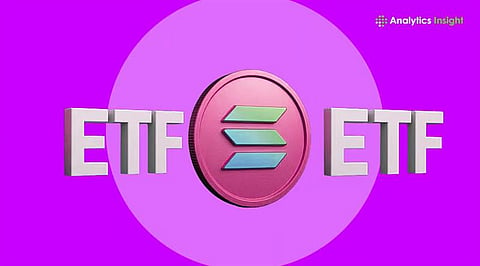

Solana ETFs create a regulated and simpler way for companies to gain Solana exposure without handling on-chain assets.
These ETFs can support Crypto Treasury Management by improving liquidity, accounting clarity, and potential yield options.
Despite convenience, market volatility and regulatory shifts remain major factors for any corporate crypto strategy.
The introduction of spot Solana ETFs marks an important moment for companies exploring digital assets. As market structures mature, traditional finance now has a clearer path to participating in Solana without managing tokens directly. This development is especially relevant for crypto treasury management, where stability, regulation, and access to liquidity matter as much as innovation.
The interest in Solana has been growing rapidly, with a range of major asset managers filing for spot ETFs throughout 2025: VanEck, 21Shares, Franklin Templeton, Bitwise, CoinShares, Fidelity, among others, have filed proposals that detail how their funds would hold SOL and, in some cases, even include features for generating yield by staking. In late filings, Franklin Templeton drew attention with an extremely competitive fee of around 0.19%, signaling it was pushing hard to capture institutional demand.
These filings highlight the growing recognition of Solana as a large-cap crypto asset. Its market capitalization recently ranged between $70 and $100 billion, and its daily trading volume continues to increase as more institutions look at structured products rather than direct token exposure. With this backdrop, regulated ETFs make Solana more accessible for treasuries that need secure, compliant ways to hold volatile assets.
Also Read: Best Solana Altcoins to Watch for 5X Growth in 2025
Solana ETFs provide a cleaner path for corporations into crypto without the complexities that come with storing and managing tokens. Without worrying about keeping private keys, risks in smart contracts, or selecting validators, treasuries can hold a regulated security traded on familiar stock exchanges. This lowers many operational risks and reduces the need to build internal blockchain expertise.
Another advantage is liquidity: ETFs allow buying and selling during market hours with quick settlement, which makes it easier for treasury managers to adjust positions, raise cash, or unwind exposure when needed. This level of access is more predictable than relying on crypto exchanges, especially during periods of market stress or heavy volatility.
Some ETF filings include staking as part of the fund's structure. This would potentially generate yield upon approval, by allowing the fund to participate in Solana's proof-of-stake network. For corporate treasuries, it means the chance to earn additional return on idle capital without performing technical tasks themselves.
However, staking also involves risks. Even for those handled by the ETF manager, there are concerns about slashing penalties and lockup periods, and validator performance. Treasuries will need to understand how each fund handles staking rewards, withdrawal deadlines, and insurance protection. The presence of staking might make one ETF more attractive than another; however, it does require clear governance and internal risk controls.
Even with the convenience of ETFs, Solana price volatility still exists. The asset has seen sharp rises and declines over short periods, and this volatility can affect corporate balance sheets, debt ratios, and investor sentiment. While the ETF structure makes it easier to hold the asset, it does not reduce the underlying market risk.
Regulation is another source of uncertainty. On one hand, approvals of ETFs would indicate an increasing appetite for crypto in regulated markets; on the other hand, policies can change. Governments could adjust reporting standards, tax treatment, or rules around trading, which then might affect how companies utilize Solana ETFs for treasury purposes.
Recent changes within the crypto market have shown that in times of market stress, firms may need to liquidate their holdings rapidly, and treasuries should be prepared for such an event.
Companies could use the ETFs to diversify their reserves with a small, manageable allocation into crypto. Since the fund is regulated, this approach allows firms to explore the long-term potential of Solana without transforming internal operations.
Some treasuries may utilize ETFs for liquidity management. With staking included, they may also be used as short-term yield instruments, though treasuries would still need to implement policies to manage market volatility.
Others may utilize ETFs to facilitate hedging strategies. Since ETFs are more compatible with the current set of financial instruments, it is easier for companies to build hedges or derivatives positions for risk management while remaining exposed to the underlying asset.
Treasury departments considering leveraging Solana ETFs would have to assess the best custody practices, insurance coverage, and how each fund manages staking. They also need clear valuation guidelines, reporting, and liquidity planning. The internal rules may include position limits, external valuation checks, or pre-approved brokers for trading in ETFs.
Also Read: Will Solana Be Worth More Than XRP by 2030?
The introduction of spot Solana ETFs gives businesses a regulated and simplified way to hold SOL. This development could influence crypto treasury management and Solana price prediction by offering better liquidity, clearer accounting, and optional staking income through professional fund structures.
As more regulated products enter the market, the relationship between crypto and corporate treasury strategies is set to deepen in a more controlled and transparent environment.
1. What are Solana ETFs?
Solana ETFs are exchange-traded funds that give investors regulated exposure to Solana without directly holding the crypto asset.
2. How can Solana ETFs help in Crypto Treasury Management?
They simplify custody, improve reporting, and offer easier liquidity compared to managing Solana directly on-chain.
3. Do Solana ETFs include staking rewards?
Some proposed ETFs plan to include staking features, allowing funds to generate yield from Solana’s proof-of-stake network.
4. Are Solana ETFs safer than holding crypto directly?
They reduce operational risks like key management, but the underlying asset volatility and regulatory risks still remain.
5. Can businesses use Solana ETFs for diversification?
Yes, companies can use them to gain controlled exposure to crypto markets as part of a broader treasury diversification strategy.
